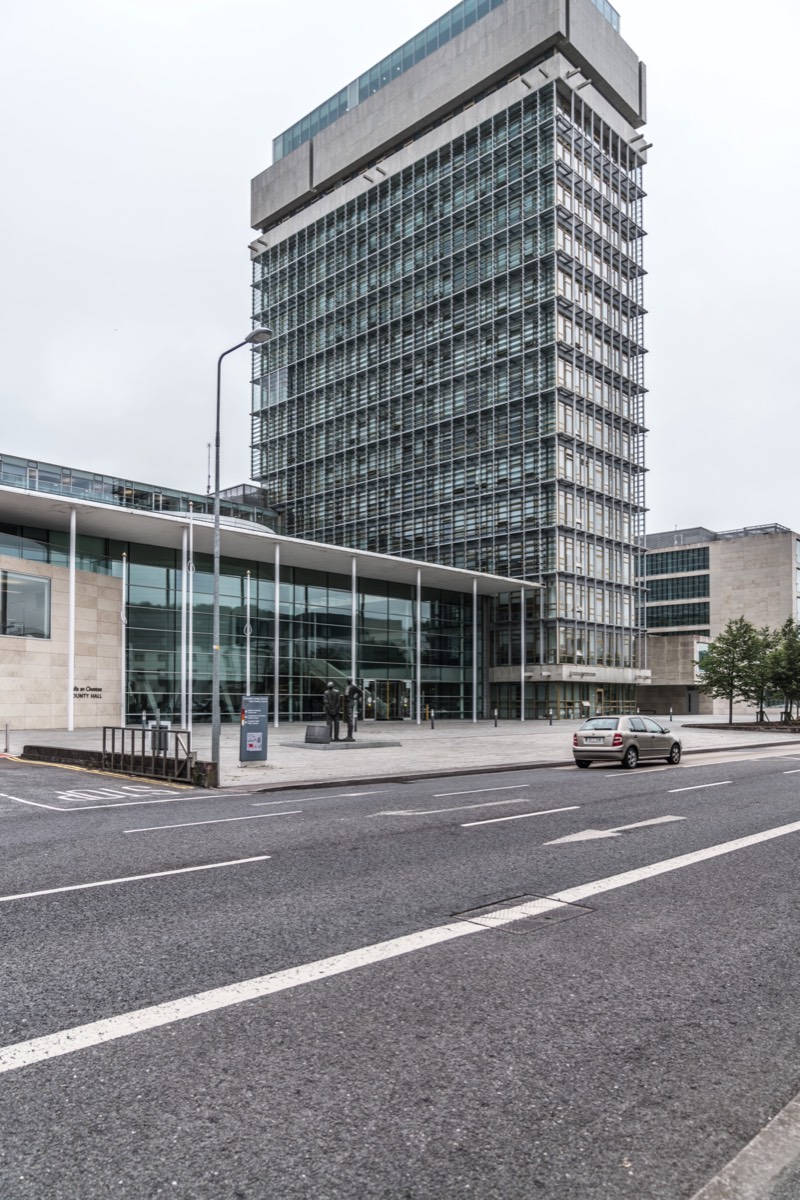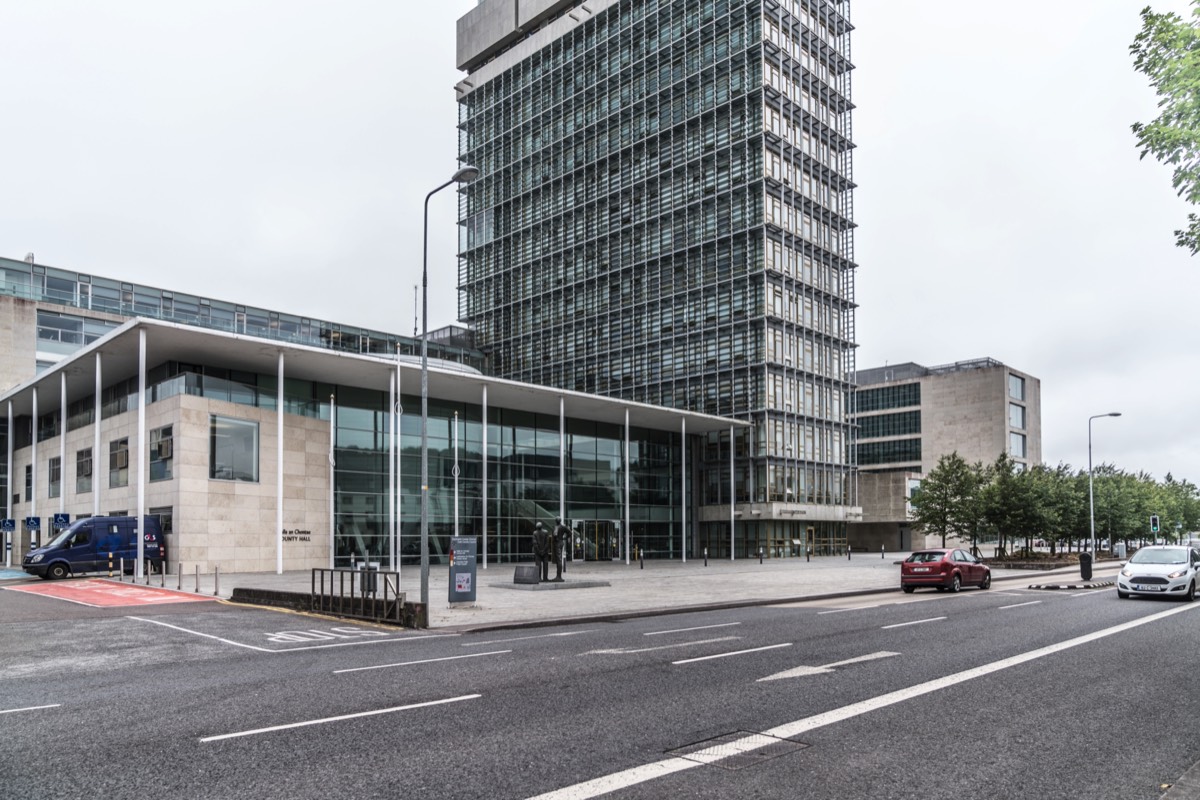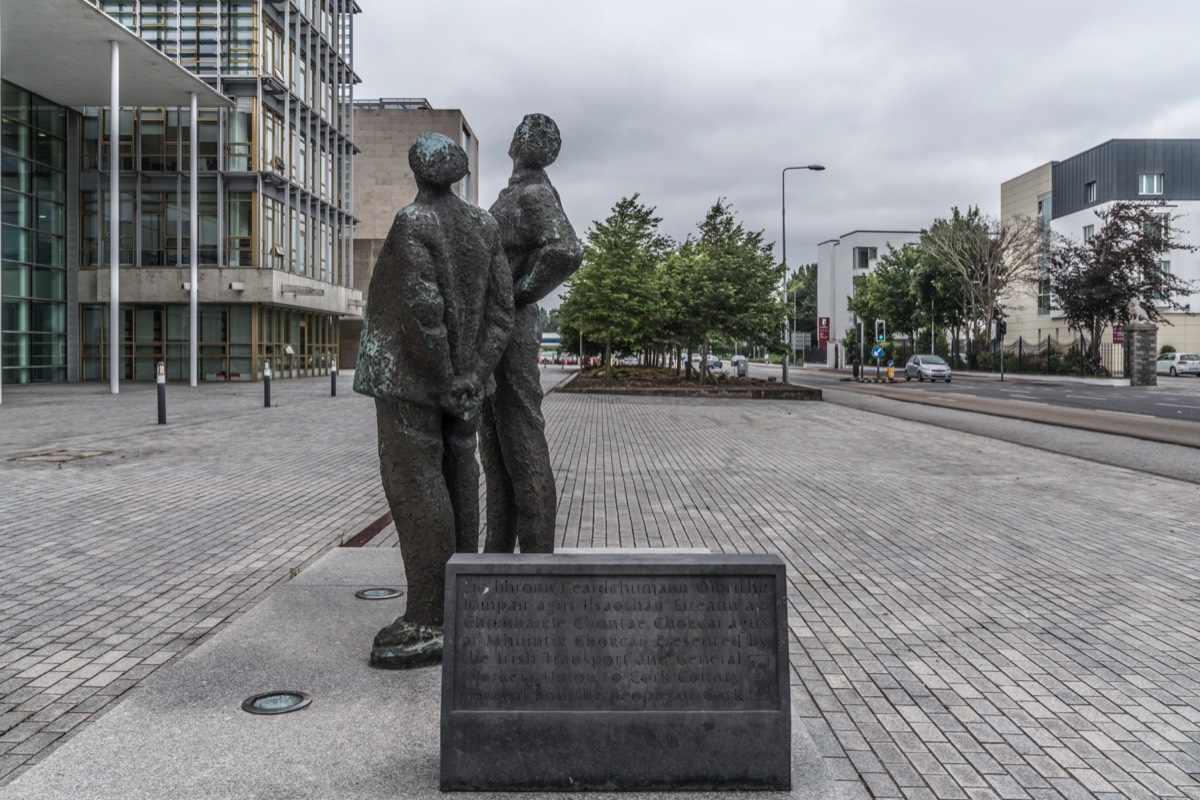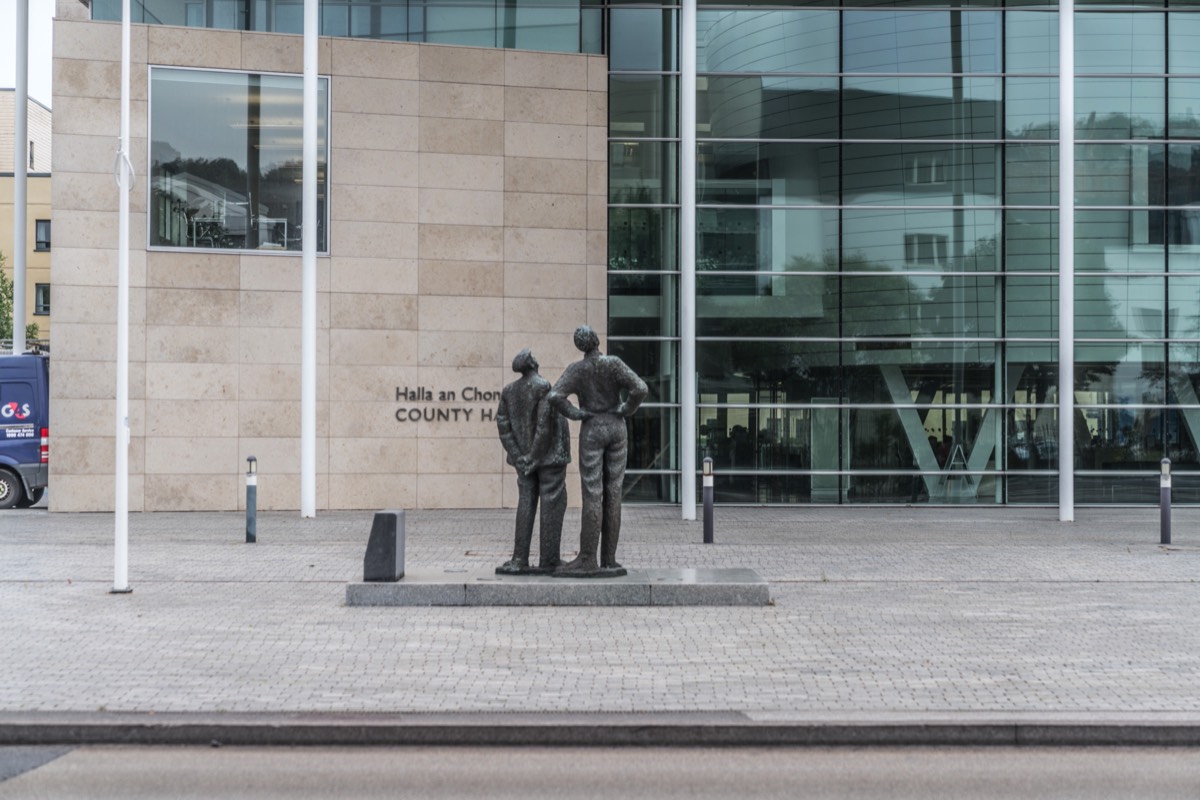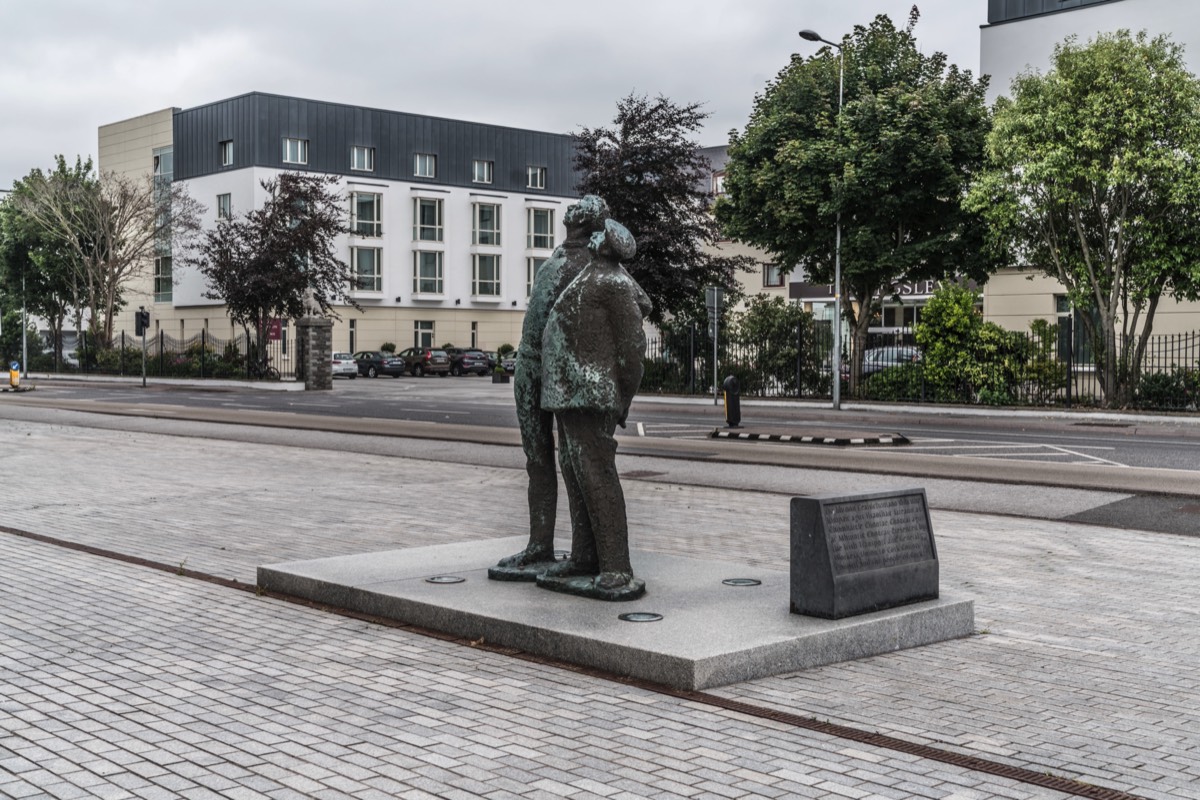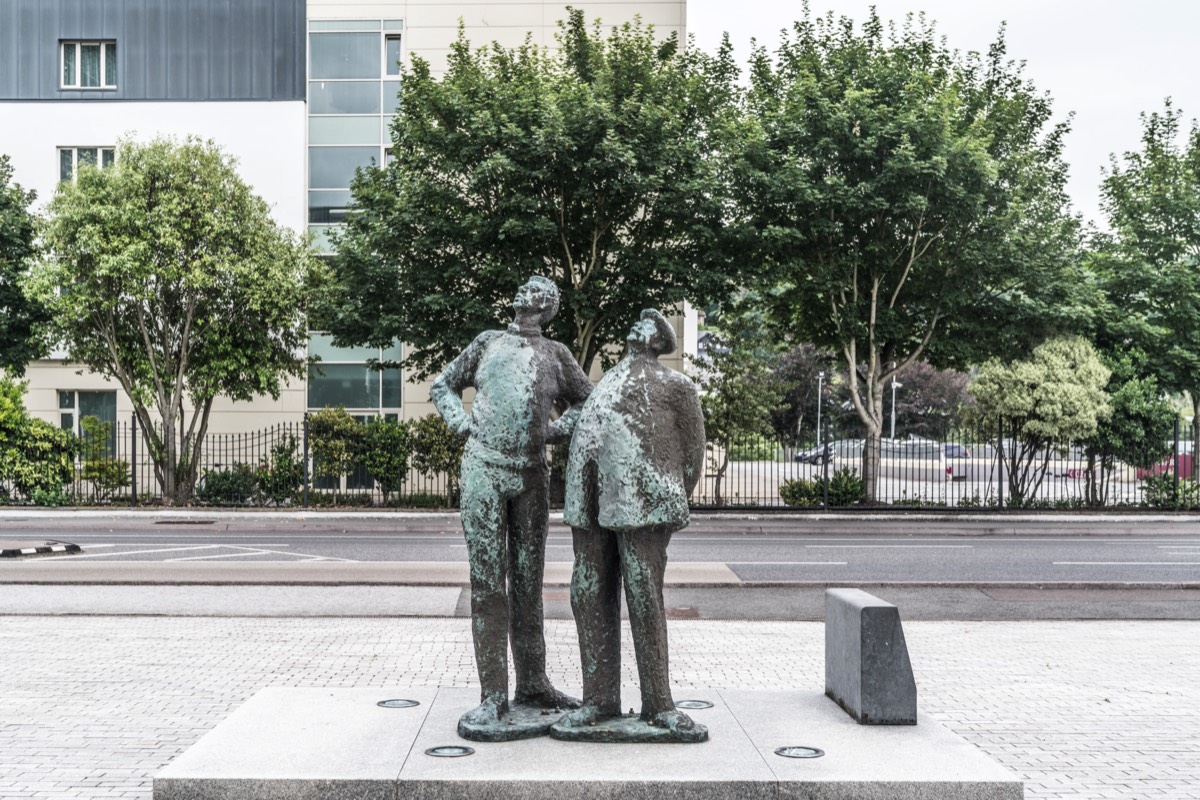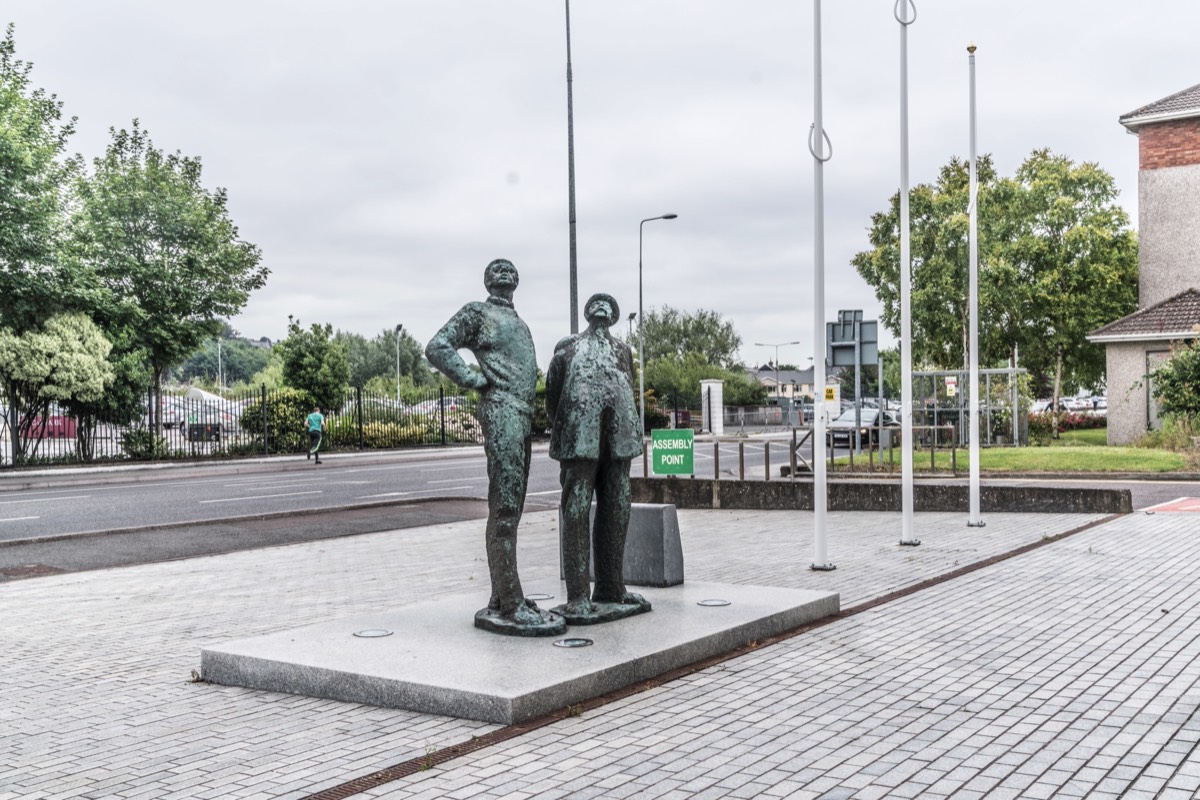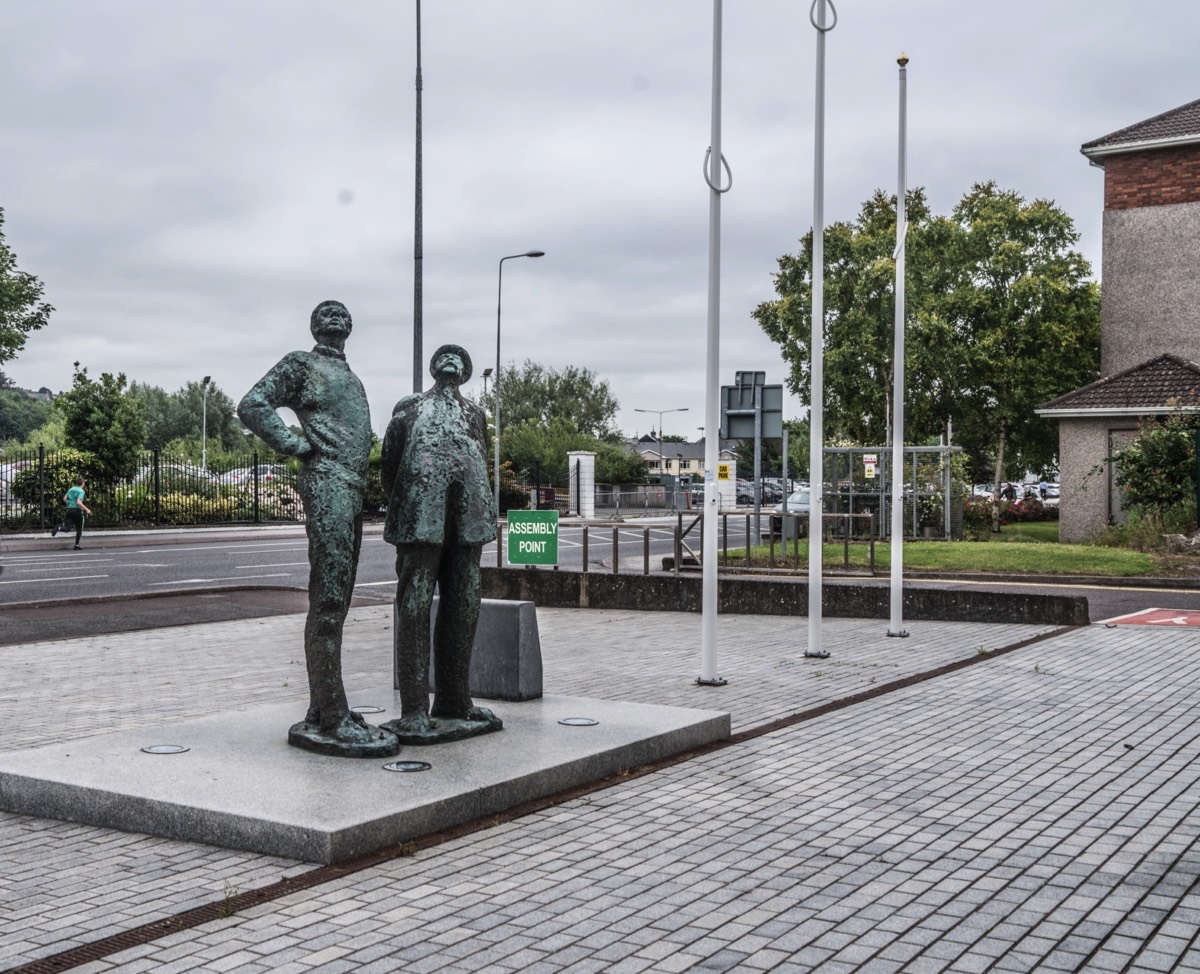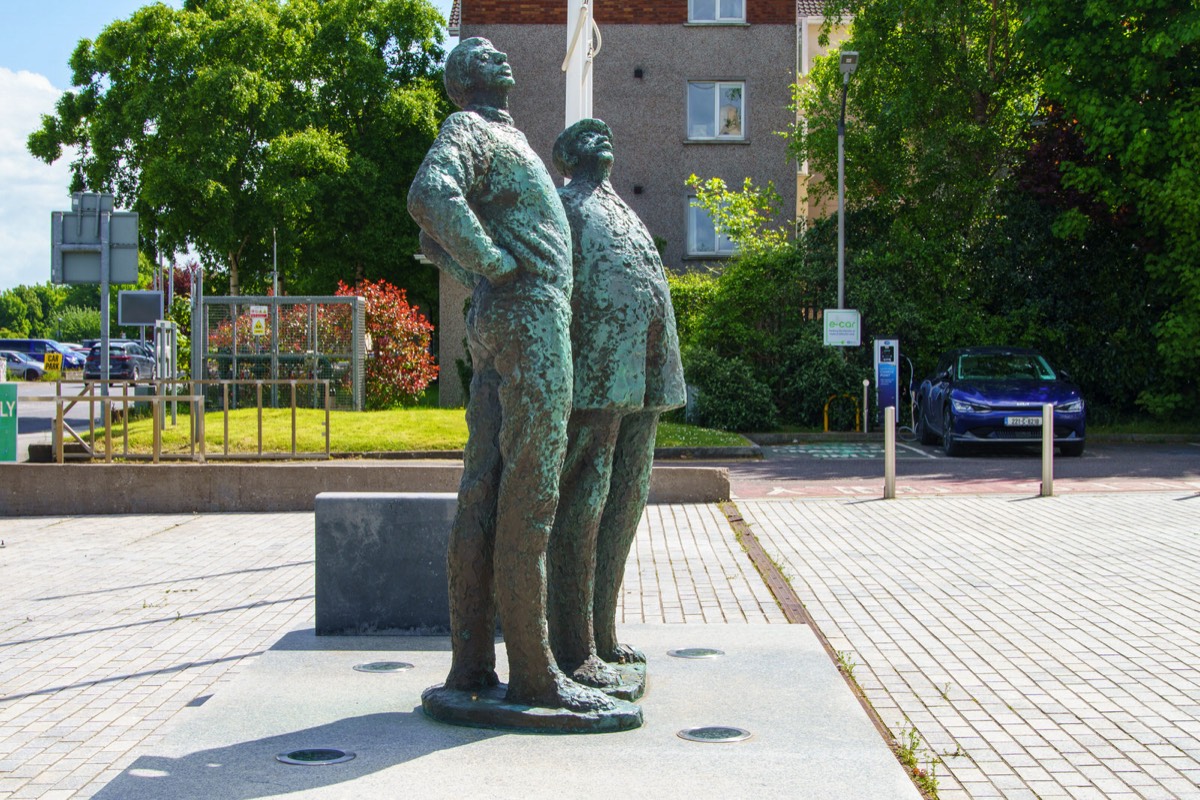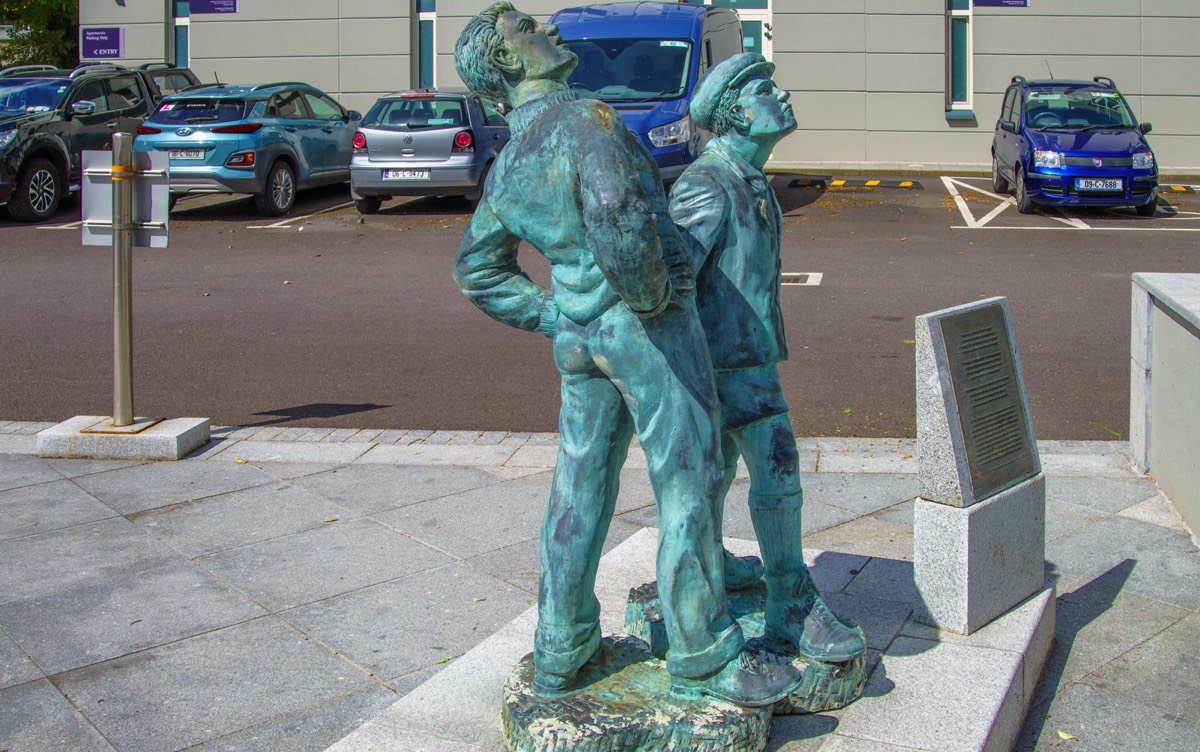TWO WORKING MEN
TWO WORKING MEN IN CORK [OISIN KELLY’S SECOND PUBLIC ART INSTALLATION]
I like this for many reasons but the main thing is that it captures a time in history that will never return but as one local told me that it is most likely that the two men spent their early years in Upton and that it is most likely that they spent most of their remaining years on the dole. Until then I had never heard of Upton so I am going to take this opportunity to tell you about was in fact a nightmare of a place and what is more upsetting that such places were operational in the late 1960s.
St. Patrick's Industrial School, Upton was an industrial school in Upton, County Cork. A local judge suggested setting up a reformatory school to serve Cork and the local Society of Saint Vincent de Paul set up a committee in 1858 to plan it. They bought a 112-acre (0.45 km2) farm near Upton, County Cork and asked the Rosminians to run it. Richard Brash designed a building which was completed in 1860. The main building was in the shape of a square around a central courtyard. In 1872 the lease was transferred to the Rosminians.
When the Industrial Schools Act was extended to Ireland in 1868 the Rosminians applied to have the school classed as an industrial school, which happened in 1889. It was called Danesfort Industrial School and operated until October 1966.
The farm increased in size over the years, eventually reaching about 220 acres (0.89 km2) at the time of its closure.
The school closed because of the falling number of boys, lack of trained staff, and reorganisation and rationalisation led to the closure which had been discussed for a number of years. A fire that occurred a few months before the closure destroyed a large part of the building, but it was not the reason for closure.
In 1972 it reopened to as a centre for adults who were mentally handicapped or who had learning difficulties. Although the Rosminians handed over ownership to the state in 2003 they continue to exercise a pastoral role.
Industrial schools were required to keep punishment books - records of misconduct and punishments. Of all the industrial schools, only Upton and St. Joseph’s Industrial School, Dundalk were able to produce them, even then they only covered a fraction of the time under investigation.
The latter book covers a period covered by the Commissions' remit, but the Commission criticised it for being less systematic, less complete and inconsistency in breaches of rules listed. Despite this, there is enough evidence in the second book to show that punishments were as described by those complaining of abuse and not as described by some former staff.
Punishment was excessive and brutal. It was used by both religious and lay staff for control and was not supervised.
Sexual abuse by members of the religious order was a chronic problem and it was dealt with in a manner that put the interests of the order, the institution and even the abuser ahead of that of the children. Abusers were transferred to other institutions, putting children at those institutions at risk. The order was aware of the criminal nature of the abuse, but did not treat it as a crime. The action of one Brother Alfonso (a pseudonym) exposed many abusers.
Abuse by boys was not regarded by staff as serious and was downplayed to protect the reputation of the school. The Department of Education did not carry out its responsibilities in regard to supervising the school or protecting children.
Abuse by boys was not regarded by staff as serious and was downplayed to protect the reputation of the school.[14] The Department of Education did not carry out its responsibilities in regard to supervising the school or protecting children.
Across the road there is what appears a joke or ‘send-up’ version of this sculpture. I would describe it as a sculpture of the two men when they were young boys. I will upload photographs later today.
The statues consist of two men, one tall and thin and the other shorter and stout. The shorter man is shown wearing a cap and clasping his hands behind his back while the taller man's hands are placed on his hips. Both men are gazing skyward, ostensibly at the top of the building. The statue's key message is to profile the common "everyday Irish person" admiring the finished product of work in a modern Ireland.
In the years after their unveiling, the statues became known locally as "Cha and Miah". The label derives from the names of two "everyman" Cork characters on the Hall's Pictorial Weekly television show which became popular in the early 1970s.
Two Working Men became Kelly's second statue on public display, after his acclaimed Children of Lir was unveiled at Dublin's Garden of Remembrance in 1966.That year, Kelly received a commission for a new statue, to be erected outside Liberty Hall in Dublin, which at the time was Ireland's tallest building and the headquarters of the SIPTU trade union.
Before the statues were to be moved outside Liberty Hall however, SIPTU deemed that they would pose a traffic hazard.
The work was instead unveiled in front of Cork's new county hall building in 1969, which during the time the statues were being made had unseated Liberty Hall as the tallest building in Ireland.It would remain the tallest building in Ireland until 2008.
The statues were removed for a period during the redevelopment of the County Hall, but were replaced in 2006.
I like this for many reasons but the main thing is that it captures a time in history that will never return but as one local told me that it is most likely that the two men spent their early years in Upton and that it is most likely that they spent most of their remaining years on the dole. Until then I had never heard of Upton so I am going to take this opportunity to tell you about was in fact a nightmare of a place and what is more upsetting that such places were operational in the late 1960s.
St. Patrick's Industrial School, Upton was an industrial school in Upton, County Cork. A local judge suggested setting up a reformatory school to serve Cork and the local Society of Saint Vincent de Paul set up a committee in 1858 to plan it. They bought a 112-acre (0.45 km2) farm near Upton, County Cork and asked the Rosminians to run it. Richard Brash designed a building which was completed in 1860. The main building was in the shape of a square around a central courtyard. In 1872 the lease was transferred to the Rosminians.
When the Industrial Schools Act was extended to Ireland in 1868 the Rosminians applied to have the school classed as an industrial school, which happened in 1889. It was called Danesfort Industrial School and operated until October 1966.
The farm increased in size over the years, eventually reaching about 220 acres (0.89 km2) at the time of its closure.
The school closed because of the falling number of boys, lack of trained staff, and reorganisation and rationalisation led to the closure which had been discussed for a number of years. A fire that occurred a few months before the closure destroyed a large part of the building, but it was not the reason for closure.
In 1972 it reopened to as a centre for adults who were mentally handicapped or who had learning difficulties. Although the Rosminians handed over ownership to the state in 2003 they continue to exercise a pastoral role.
Industrial schools were required to keep punishment books - records of misconduct and punishments. Of all the industrial schools, only Upton and St. Joseph’s Industrial School, Dundalk were able to produce them, even then they only covered a fraction of the time under investigation.
The latter book covers a period covered by the Commissions' remit, but the Commission criticised it for being less systematic, less complete and inconsistency in breaches of rules listed. Despite this, there is enough evidence in the second book to show that punishments were as described by those complaining of abuse and not as described by some former staff.
Punishment was excessive and brutal. It was used by both religious and lay staff for control and was not supervised.
Sexual abuse by members of the religious order was a chronic problem and it was dealt with in a manner that put the interests of the order, the institution and even the abuser ahead of that of the children. Abusers were transferred to other institutions, putting children at those institutions at risk. The order was aware of the criminal nature of the abuse, but did not treat it as a crime. The action of one Brother Alfonso (a pseudonym) exposed many abusers.
Abuse by boys was not regarded by staff as serious and was downplayed to protect the reputation of the school. The Department of Education did not carry out its responsibilities in regard to supervising the school or protecting children.
Abuse by boys was not regarded by staff as serious and was downplayed to protect the reputation of the school.[14] The Department of Education did not carry out its responsibilities in regard to supervising the school or protecting children.
Across the road there is what appears a joke or ‘send-up’ version of this sculpture. I would describe it as a sculpture of the two men when they were young boys. I will upload photographs later today.
The statues consist of two men, one tall and thin and the other shorter and stout. The shorter man is shown wearing a cap and clasping his hands behind his back while the taller man's hands are placed on his hips. Both men are gazing skyward, ostensibly at the top of the building. The statue's key message is to profile the common "everyday Irish person" admiring the finished product of work in a modern Ireland.
In the years after their unveiling, the statues became known locally as "Cha and Miah". The label derives from the names of two "everyman" Cork characters on the Hall's Pictorial Weekly television show which became popular in the early 1970s.
Two Working Men became Kelly's second statue on public display, after his acclaimed Children of Lir was unveiled at Dublin's Garden of Remembrance in 1966.That year, Kelly received a commission for a new statue, to be erected outside Liberty Hall in Dublin, which at the time was Ireland's tallest building and the headquarters of the SIPTU trade union.
Before the statues were to be moved outside Liberty Hall however, SIPTU deemed that they would pose a traffic hazard.
The work was instead unveiled in front of Cork's new county hall building in 1969, which during the time the statues were being made had unseated Liberty Hall as the tallest building in Ireland.It would remain the tallest building in Ireland until 2008.
The statues were removed for a period during the redevelopment of the County Hall, but were replaced in 2006.
SORRY FOR THE DELAY
THE PHOTO DIARY IS NOT LIMITED TO CORK AS I ONLY VISIT THE CITY ONCE EVERY YEAR AND 2020 MAY BE AN EXCEPTION. I AM BASED IN DUBLIN BUT DURING THE SUMMER MONTHS I VISIT BELFAST, LIMERICK, GALWAY, KILKENNY AND WATERFORD AND USUALLY DEVOTE A WEEK TO PHOTOGRAPHING EACH OF THE CITIES IN QUESTION
CHA AND MIAH WHEN THEY WERE BOYSSTATUES BY BRENDAN BYRNE AT THE KINGSLEY HOTEL IN CORK
You will find links to buy products from Amazon, Google and other partners. If you click on these links, you’ll find that the URL includes a small extra piece of text which identifies that the click came from my websites. This text is an affiliate code, and it means that I get a small percentage of the money you spend if you choose to buy that product, or, in some cases, other products from the site soon after. These affiliate links help pay the costs of producing my websites and ensure that the content is free to you.
